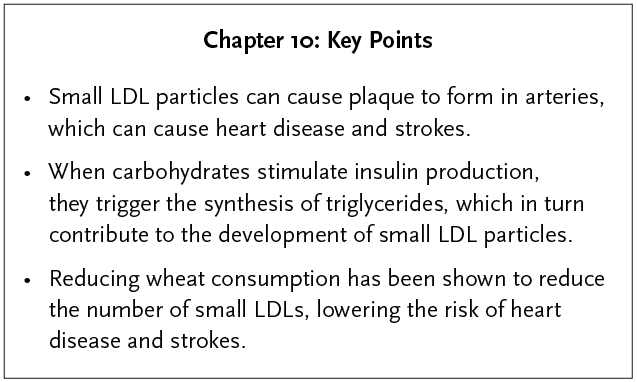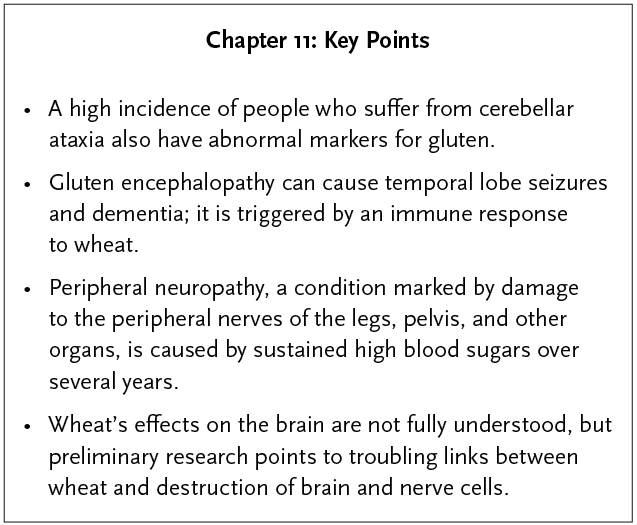Summary: Wheat Belly ...in 30 Minutes (6 page)
Read Summary: Wheat Belly ...in 30 Minutes Online
Authors: 30 Minute Health Summaries


MY PARTICLES ARE BIGGER THAN YOURS: WHEAT AND HEART DISEASE
Overview
Diets high in carbohydrates stimulate the production of insulin, which triggers fatty acid synthesis in the liver. The liver releases these fatty acids in the form of triglycerides â which provide energy for metabolic processes. Through the processes of metabolism, triglycerides are turned into small particles called low-density lipoproteins (LDLs) â particles that carry fatty acids through the bloodstream. The more insulin, the more triglycerides, and the more triglycerides, the smaller the LDLs. These very small LDLs linger in the body and can build up in the lining walls of the arteries and lead to heart disease and stroke.

“Anything that provokes an increase in blood sugar will also, in parallel, provoke small LDL particles. Anything that keeps blood sugar from increasing, such as proteins, fats, and reduction in carbohydrates such as wheat, reduces small LDL particles.”
â Dr. William Davis,
Wheat Belly

Chapter Summary
Davis says LDL particles are not cholesterol, although they are typically thought of that way in the medical and pharmaceutical communities. The precursor of these LDL particles are very-low-density lipoprotein particles (VLDLs), which are produced in the liver. VLDLs are a package of proteins and fatty acids in the form of triglycerides and cholesterol. In the bloodstream, they transport these fatty acids to peripheral tissues and metabolize them to be absorbed. What is left behind are LDL particles, which are eventually taken up by the liver.
The size of the LDL particles depends on how much triglyceride the VLDLs give up. The more they give up, the smaller the resulting LDL particle.
While large LDL particles are easily recognized by receptor cells in the liver and taken up for disposal, small LDL particles are less easily recognized and remain in the bloodstream longer. They are more likely to be taken up by inflammatory white cells that reside in the walls of arteries and form atherosclerotic plaque â a deposit of fat that accumulates in the lining of the arteries. Numerous studies show that the presence of atherosclerotic plaque increases the likelihood of having a heart attack or stroke.
While carbohydrates contain almost no triglycerides themselves, they are very good at stimulating the liver to create them. Davis says as long as carbohydrate consumption is sustained, the body continuously manufactures triglycerides, resulting in more small LDL particles.

“Carbohydrates possess the unique capacity to stimulate insulin, which in turn triggers fatty acid synthesis in the liver, a process that floods the bloodstream with triglycerides.”
â Dr. William Davis,
Wheat Belly

In a study by Dr. Jeff Volek at the University of Connecticut, when participants reduced their carbohydrate intake to
1
0 percent of total calories over a twelve-week period, small LDL particles were reduced by 26 percent. This study suggests that reducing wheat consumption is an important component of heart health.


IT'S ALL IN YOUR HEAD: WHEAT AND THE BRAIN
Overview
According to Davis, while scientists are just beginning to understand the effects that wheat consumption has on the brain, there is some evidence that wheat damages brain tissue. Certain types of ataxia (loss of full control of body movements), neuropathy (a disease or dysfunction of the nerves), and encephalopathy (any disease in which some agent affects the functioning of the brain) show some correlation to gluten sensitivity and/or high blood glucose levels. While these conditions are progressive, they may show some improvement when wheat is eliminated from the diet.

“Among the most disturbing of wheat's effects are those exerted on brain tissue itself â not âjust' on thoughts and behavior, but on the cerebrum, cerebellum, and other nervous system structures, with consequences ranging from incoordination to incontinence, from seizures to dementia.”
â Dr. William Davis,
Wheat Belly

Chapter Summary
In Chapter 4, we learned that wheat can bind with morphine receptors on the brain, creating exorphins that affect moods and cravings. In this chapter, Davis explores the effects of wheat on brain tissue. He cites three particular brain disorders that may result from a diet high in wheat.
Cerebellar ataxia causes impaired coordination and balance, and eventually loss of all bodily functions. While the cause is often unknown, Davis notes that 50 percent of those with unexplained ataxia have abnormal blood markers showing gluten sensitivity. The destructive immune response accountable for the gastrointestinal signs of celiac disease can also cause an immune attack on brain cells. The antigliadin antibodies (gliadin is the protein found in gluten; antigliadin antibodies are produced in response to gluten) can bind to cells that are unique to the cerebellum, the part of the brain impaired in ataxia.
Gluten encephalopathy presents as migraines and incoordination, and can lead to dementia and temporal lobe (the part of the brain that organizes sensory input) seizures. Davis reports that
1
percent to 5.5 percent of all celiac sufferers are likely to be diagnosed with these seizures. Studies show that when wheat and gluten are eliminated from the diet, temporal lobe seizures improve.
Peripheral neuropathy affects the nerves in the legs, pelvis, and other organs; high blood sugar levels, sustained over several years, damage the nerves. A common cause is diabetes. Unlike brain cells, peripheral nerve cells can repair themselves to some extent, although not completely. Some studies show eliminating wheat from the diet results in improvement in peripheral neuropathy.
Gluten is the component of wheat most commonly associated with autoimmune phenomena. However, Davis suggests there are other components of wheat that can be equally harmful. Wheat exorphins, for example, can lead to addictive reactions to wheat consumption. And glucose-insulin reactions caused by the high glycemic index of wheat can lead to peripheral neuropathy.
Scientists are just beginning to understand the ways that wheat affects the brain. Diagnoses are complicated by the fact that there is not a consistent set of symptoms but rather a variety of neurological responses. At this point, Davis's best recommendation is to avoid consuming wheat.

“The research into the relationship of wheat, gluten, and brain damage is still preliminary, with many unanswered questions remaining, but what we do know is deeply troubling.”
â Dr. William Davis,
Wheat Belly


